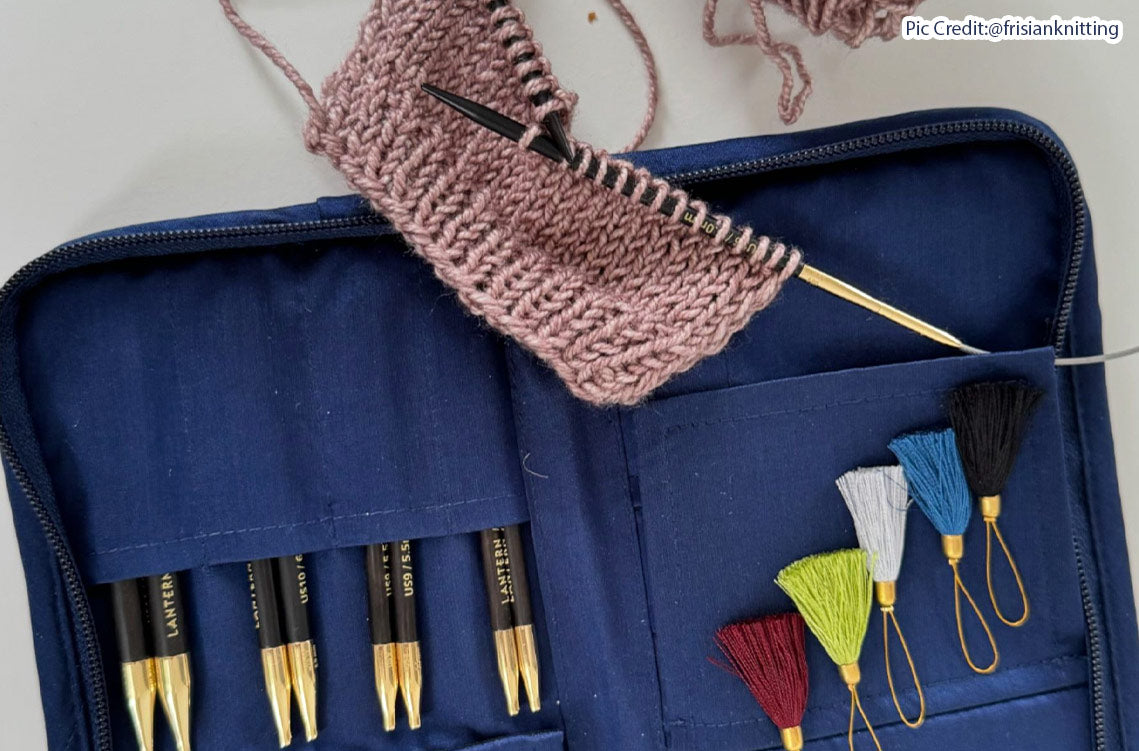
Slip Slip Purl is a knitting decrease technique used in projects that require shaping. Say, for example, projects such as hats, socks, sweaters, and even asymmetrical shawls. You can work out the handy decrease for any of your projects with any of your knitting needles. It is the purl counterpart to the slip slip knit (SSK) technique. You basically work the decrease in a row or round of purl stitches. So, if you’ve mastered the slip slip knit (SSK) technique, you can work out SSP. Want to expand your knitting skills? Grab your favorite Lantern Moon knitting needles as we walk you through the method.
What is Slip Slip Purl (SSP)?
The slip slip purl technique is abbreviated as SSP. It is the decrease technique that you work on a row or round of purl stitches. It’s a right-leaning decrease that has a corresponding left-leaning technique, purl decrease, purl two together (p2tog). What appears to be an SSP on the purl side looks similar to an SSK when seen from the knit side. If you are working on a project, knit back and forth, such as a scarf, shawl, or even a blanket with single-pointed needles or circular knitting needles, then you can see both sides and the difference in stitch appearance. But, if you are knitting round projects such as socks or sweaters with circular needles or a set of double-pointed needles, the wrong side of the project
This technique is particularly useful in various patterns, such as lace, shaping garments, or other designs where a clean and flattering decrease is desired. SSP creates a subtle and professional-looking finish, perfect for areas where knitting meets tailoring, such as armholes and necks, or when creating shapes in a shawl or a cardigan.
While, in essence, you work with purl stitches and decrease a stitch, knitters consider it a challenging knitting decrease. Well, one reason is that the purl stitch is tricky for many to master, as knitters face changes in tension. But with time and practice, you can work SSP smoothly.
How to Work the Slip Slip Purl Technique
To perform the Slip Slip Purl (SSP) decrease, follow these steps:
Step 1 - Prepare to Work the Decrease:
Begin by knitting up to the point where you need the decrease. For example, if you are working in a stockinette stitch, work till the stitch before your desired decrease. It is important to note that you work SSP only in a row or round of purl stitches. This point is important for a stockinette stitch pattern for project knit in the round with circular knitting needles or DPNs. Refer to our beginners guide on stockinette stitch to learn more.
Step 2 - Slip the First Stitch
Insert your knitting needle into the first stitch on the left needle as if to knit. Slip this stitch onto the right needle without knitting it.
Step 3 - Slip the Second Stitch
Now, insert your needle into the next stitch on the left needle (again, as if to knit) and slip this stitch onto the right needle as well. At this point, you have two slips on your right needle.
Step 4 - Purl the Two Slipped Stitches Together
Using your left needle, pick up the two slipped stitches on the right needle. Insert the needle in the same manner as you would for a purl stitch. Wrap your yarn around the needle and pull it through both slipped stitches, effectively purling them together.
This action of purling the two stitches together not only decreases the stitch count by one but also creates the slant characteristic of this technique.
Place a stitch marker if you have to repeat the instruction. Carry stitch markers for smooth crafting sessions.
Why Use Slip Slip Purl?

The SSP leaves a tidy decrease, enhancing the overall aesthetic of the knitting project. It is particularly advantageous in lace patterns or when shaping garments. Unlike other decreases like purl two together (p2tog), which leans to the right, SSP leans to the left. This balanced approach in shaping creates symmetry in designs, especially when paired with other left- and right-leaning decreases.
SSP can be used in various projects, from garments to accessories, and can be easily integrated into different stitch patterns. It is equally effective in both simple and complex designs.
The Slip Slip Purl technique is used in various knitting patterns. Here are some common applications:
1. Shaping Garments - When knitting fitted garments like sweaters and cardigans, SSP is often used to shape armholes and necklines for a customized fit.
2. Lace Knitting - In lace patterns, combining SSP with other decreases can create intricate designs and motifs that are appealing.
3. Slip Stitch Patterns - In combinations of slip stitch and texture work, SSP can be integrated into the design to maintain texture while also providing decreases where necessary.
The Slip Slip Purl technique is an essential skill for every knitter. Whether you are creating a simple scarf, an intricate shawl, or a tailored sweater, embrace this technique to transform your knitted fabric into an artful expression of creativity and design. With Lantern Moon knitting needles, enjoy the smooth crafting experience. For tricky techniques like SSP, the precise points help you work with all kinds of yarn, while the luxury silk-like finish of ebony wood allows a smooth glide of stitches regardless of the yarn.
